-
- SHOP
- Pool Ramp for Dogs
- For People
- For Pets
- Gallery
- Blog
- Our Company
- Cart
- Login
- Newsletter
- Free US Shipping on orders over $79!
Teaching your hesitant dog to swim in a pool can be an intensive yet rewarding journey. While some dogs take to water naturally, others may find the pool intimidating. Overcoming this fear requires patience, understanding, and a gentle approach to help your furry friend feel safe and confident.
In this blog, we’ll explore effective techniques to gradually introduce your dog to the pool, build their trust, and transform their apprehension into enjoyment. From creating a positive environment and using motivational tools to recognizing your dog’s comfort level and celebrating small victories, we’ll guide you through every step. Whether you’re looking to provide a new form of exercise for your dog, encourage aqua-therapy for joint health, or simply want to share the joy of the pool, this blog will equip you with the strategies you need to help your dog overcome their fear of pools and embrace the water with enthusiasm.
Before you begin, it’s essential to understand why your dog might be afraid of the water. Most often, your dog’s hesitancy is due to a lack of exposure. If they haven’t been in one before, it’s natural for your pup to be reluctant to enter a pool. Another reason your dog may be hesitant to enter the pool is because they previously had a negative experience with water. Maybe they slipped off a dock or stepped into water thinking it was more shallow than it was, a negative experience with water can make your dog more wary of getting in the pool.
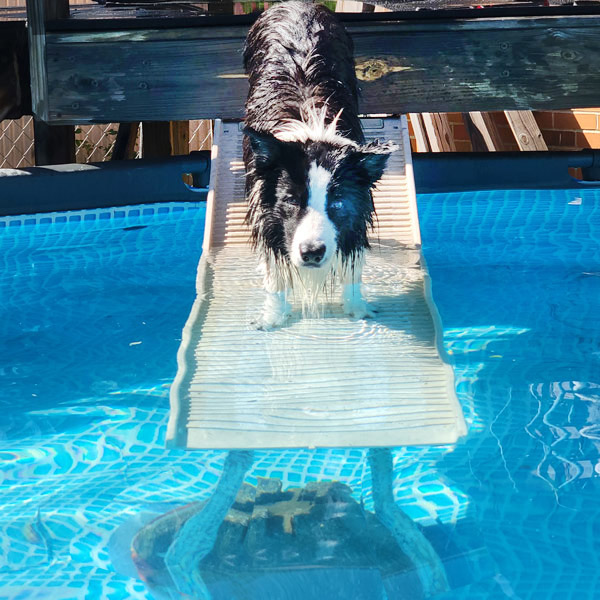
Lastly, it can simply be that some dog breeds do not enjoy water as much as others and will be naturally hesitant.
Still, no matter your dog’s starting point, you can take steps to help them feel safe around water and enjoy the pool!
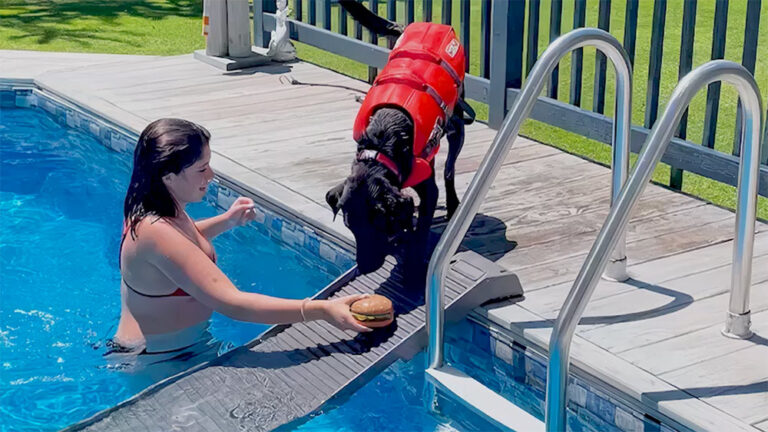
Always prioritize safety when training your dog to swim in your pool, especially if your dog has had previous negative experiences with water.
A canine life vest may be a good choice for dogs that are especially hesitant to swim. The vest will help your dog stay afloat and feel secure, making the experience less intimidating. After swimming with the vest a few times, they’ll realize that it keeps them from sinking and the anxiety of swimming will lessen. Pro Tip: Acclimate your dog to wearing the life vest before going in the water. Have your dog wear the vest outside or around the house for a while first, using plenty of treats so that the vest has a positive association.
If your dog is hesitant to enter the pool, it is crucial that they know they have a safe and reliable way to enter and exit the pool. This is why adding a dog ramp designed for pools is highly recommended. It gives your dog a safe and gradual way in and out of the water so they don’t have any added stress when swimming. The last thing you want is for your dog to be struggling with a pool ladder after an accidental or unpleasant dip in the water.
Another accessory that can help your pup feel more comfortable in the pool is pool floats made for dogs. This is especially helpful when you have a large pool because the pool floats act as rest stops. If your dog is intimidated by swimming in deep water, the pool floats give them something to grab onto if they start getting stressed.
Lastly, and the most important safety precaution, is supervision. Your dog, good swimmer or not, should not be in the pool without constant supervision. You never know when your dog might need help in the water. Plus, the constant supervision will help build trust with your dog because they know you’ll never be too far if they find themselves in a stressful situation.
No matter your dog’s reason for being hesitant to enter the water, it’s important to create a positive association with your pool. Start by creating positive experiences around the pool without forcing your dog to get in. You can start by letting your dog roam outside while you and the family enjoy the pool. Dogs often look to their owners for cues. Showing your pup that the pool can be fun will make them more likely to want to join in. You can also incorporate your dog’s favorite toys and treats to make the pool deck a fun place to be. Bring a bag of treats with you when you go into the pool. When you call your dog towards you and they come near the water, reward them with a treat!
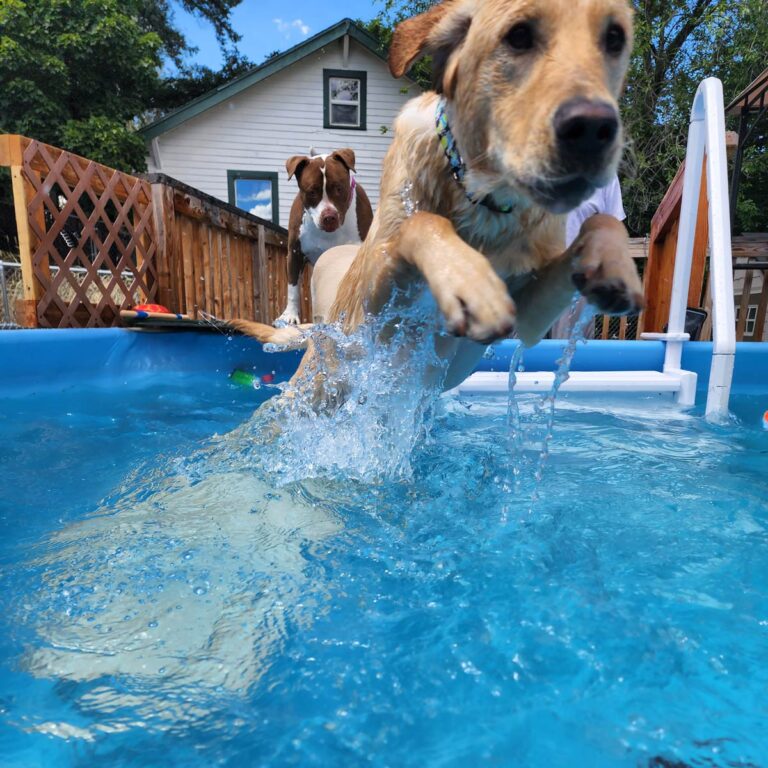
Introducing your dog to water gradually builds their confidence instead of shocking them. This is why having a pool ramp for your dog is incredibly helpful. It allows your dog to wade into the water at their own pace without needing to jump in snout first. If your dog is hesitant to use the ramp as well, we have an in-depth guide on how to get your dog comfortable with using ramps.
You can entice your dog to walk on the pool ramp by getting in the water and calling them to you. Having their favorite treats on hand always helps! When your dog steps on the ramp, reward them with their treat and some “good boy/girl’s.” Encourage them to walk further down the ramp towards you, and reward them every time they move down a little further.
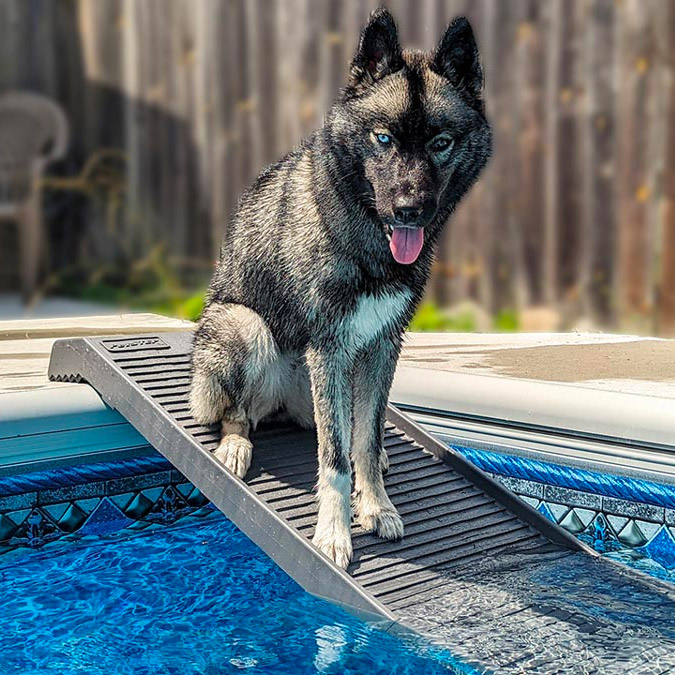
Once your dog steps off of the ramp and starts swimming, reward them even if they’re in the water for only a few seconds before returning to the ramp. This helps strengthen the positive association with water. As your dog becomes more comfortable with stepping off of the ramp, you can guide them with your arms to stray further and further away from the ramp to swim on their own. When you sense any stress, guide them back towards the ramp and reward them for venturing further into the pool.
As with any training, it’s essential to use positive reinforcement and avoid any punishment when training your dog to use the pool. It can get frustrating at times when it feels like your dog isn’t listening, but it’s important to keep your cool and to continue to practice even after setbacks. For example, always end on a positive note. If you notice your dog is becoming less willing to go down the ramp as the training session progresses, end it with a treat before you and your dog get too frustrated. This sets up the next training session to begin on a positive note as well.
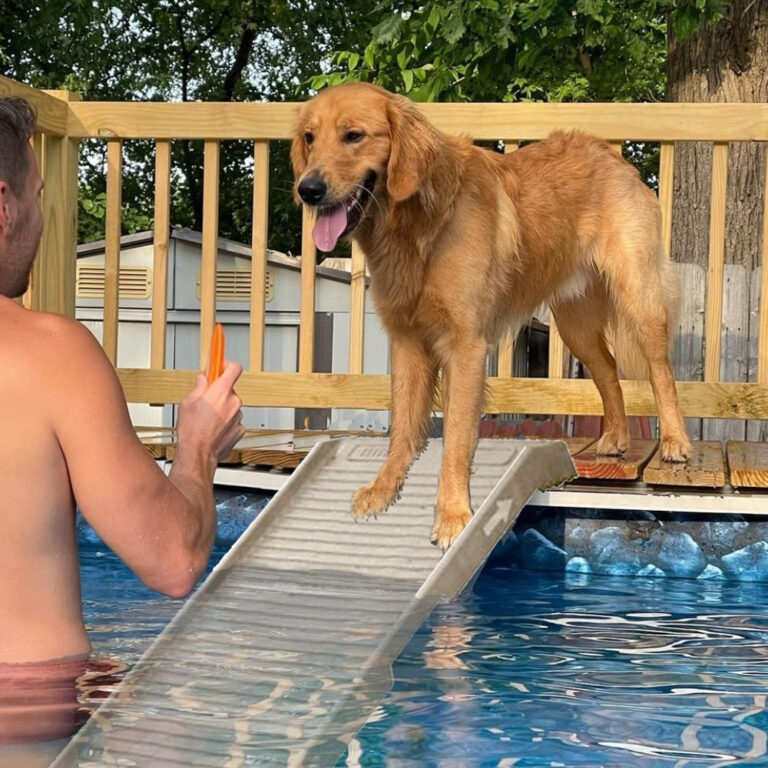
When teaching your dog to overcome their fear of swimming in a pool, patience and practice are key elements to success. Patience allows you to move at your dog’s pace, ensuring they feel safe and supported throughout the process. It’s important to recognize that each dog is unique, and what works for one may not work for another. Gradual exposure to the pool, combined with positive reinforcement and plenty of encouragement, can help build your dog’s confidence over time. Consistent practice is equally crucial, as repeated, gentle experiences with the water will help your dog become more comfortable and familiar with swimming. Celebrating small milestones and providing lots of praise will reinforce their progress and motivate them to keep trying. With a calm, patient approach and regular practice, you can help your dog transform their fear into a newfound love for swimming.
At the end of the day, the method that will best help your dog become comfortable with swimming in the pool is consistent training. Consistency helps strengthen the positive association your dog has with the pool and will make them more comfortable with each training session.
Training your dog to overcome their apprehension of your swimming pool is a journey that requires patience, persistence, and plenty of positive reinforcement. By taking small, gradual steps and always considering your dog’s comfort level, you can help them build confidence and learn to enjoy the water. Remember to celebrate every little victory along the way, and never rush the process. With consistent practice, lots of encouragement, and a calm, supportive approach, you’ll soon see your dog not just tolerating the pool but looking forward to those refreshing swims. The effort you invest in helping your dog conquer their fear will be rewarded with the joy and satisfaction of watching their doggie cannon balls, turning the pool into a source of fun and bonding for the whole family.